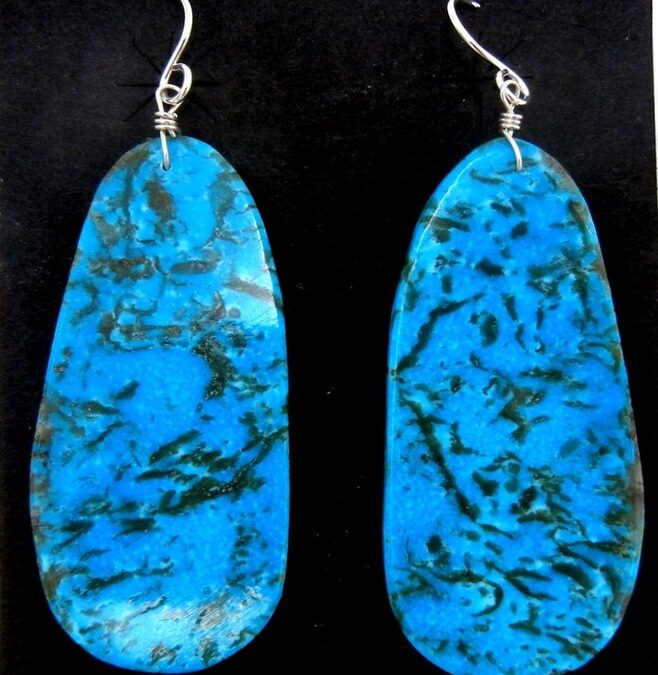Needless to say, fake turquoise jewelry isn’t worth any money. What about real turquoise jewelry?
Today we’ll discuss what makes turquoise valuable. Armed with this information, you’ll be able to see if turquoise makes a good investment choice for your future.
Cultural History
Though different North American tribes use turquoise in their jewelry, the Navajo created the Squash Blossom Necklace, one of the most iconic pieces of tribal jewelry. It’s believed the design came into being during the late 1800s.
Outside of its ceremonial uses, the necklace represents prestige and status: the bigger the Squash Blossom necklace, the more influential the wearer.
Today, authentic Navajo Squash Blossom necklaces are worth thousands of dollars. This is one example of how cultural history increases the value of turquoise jewelry.
Dwindling Mines
Many turquoise mines worldwide are quickly depleting, with some even closing.
One example is the Cerillos mine in New Mexico. Beginning in the 1800s, the increased usage of turquoise by Pueblo tribes sparked a boom in New Mexico’s turquoise mining. Though the popularity of turquoise wavered throughout the years, the mine eventually started to deplete.
Today, Cerillos no longer supplies turquoise.
Other factors making natural turquoise rare are the cost of mining and altered imports. The costs of mining dramatically rose, which forced many mines to close. China and other countries began importing cheaper turquoise to fill this gap. The main reason why this turquoise costs less is because it’s stabilized.
Stabilized turquoise uses epoxy to make lower-quality stones harder and brighter. It does not mean, however, that it is dyed or fake.
This alteration makes natural turquoise harder to find. Many believe that over 90% of the world’s turquoise is altered in some way.
Regional Requirements
Turquoise’s creation depends on certain environmental factors. First, turquoise only forms in dry, arid environments. That’s why most of the turquoise in the United States comes from desert climates.
Second, turquoise needs a source of copper and host rocks containing phosphorus and aluminum.
Not many regions worldwide provide all the factors necessary for turquoise to form, making natural turquoise harder to find.
Judging Quality
The main characteristics of genuine turquoise that are looked at when valuing what each stone is worth involve color, porosity, and matrix.
Color
There is much controversy surrounding color and value. What is usually agreed upon is the purity of turquoise color.
High-quality turquoise color is rich, clear, and consistent. Lower-quality turquoise has a cloudy, murky color that is not as vibrant.
Porosity
High-quality or highly valued turquoise has low porosity.
Every rock contains pores. A low-porosity stone has fewer pores, making it more stable. Low porous turquoise is less immune to color changes, fading, and crumbling.
High-quality turquoise falls between 5 and 6 on the Mohs Hardness Scale.
Matrix
Turquoise forms in what is called a mother or hosting rock. Hosting rocks are usually comprised of limonite or sandstone. Sometimes, deposits of this hosting rock get embedded into the turquoise. This causes a matrix.
A matrix can appear as lines embedded into the turquoise or blotches of different colors within the stone. Limonite usually produces dark brown markings, while sandstone produces lighter tan-colored markings.
High-quality or valuable turquoise doesn’t contain a matrix at all.
The second most valuable turquoise has a spiderweb matrix. A spiderweb matrix becomes highlighted when cut and polished. It looks like a delicate lattice design with turquoise showing through the lines of the lattice.
Most Valuable
When taking all of the factors that go into judging turquoise quality, the most valuable turquoise looks like this:
- Clear, vibrant color
- Low porosity
- No matrix
Least Valuable
Low-quality turquoise is highly porous, making it soft. It’s usually a murky green to yellow in color. It will have an ununiform matrix type and tends to weigh less than quality turquoise.
General Value of Different Kinds of Turquoise
The average price for turquoise cabochons is $15 to $25 per gram. Cabochons are cut and polished turquoise stones. Most jewelry uses this type of turquoise.
This price doesn’t account for quality or rarity.
High-Quality Turquoise
The highest quality turquoise (clear color, low porosity, no matrix) ranges from $1,500 to $25,000 per gram. To put this into perspective, gold is roughly $60 per gram.
Blue Lander spiderweb turquoise also falls under this category. Blue Lander was a turquoise mine located in Nevada. Founded in 1973, it was rumored to have only produced 100 pounds of turquoise. Due to its rarity and unique matrix, this turquoise is also valued at $1,500 to $25,000 per gram.
Raw Turquoise
Raw turquoise that hasn’t been altered, cut, or polished ranges from $5 to $50 per gram. Buying turquoise in this form ensures that your turquoise is natural and not stabilized.
Stabilized Turquoise
Stabilized turquoise begins its life as low-quality natural turquoise. This means it’s soft and porous. Then, it’s processed, usually using epoxy, to stabilize its color and hardness. Stabilized turquoise is worth $15 to $125 per gram.
Purple Turquoise
Purple turquoise, or Mojave, is crushed turquoise formed into a stone using epoxy. It’s then dyed purple. This fabricated stone is worth $0.50 per gram.
Where to Find Real Turquoise Jewelry
Palms Trading Company offers a wide selection of authentic turquoise jewelry. Our experienced buyers purchase directly from the artists. We understand that turquoise is an investment, and we can help you find the perfect piece that fits your budget.
Contact us today to find your next turquoise investment piece.



